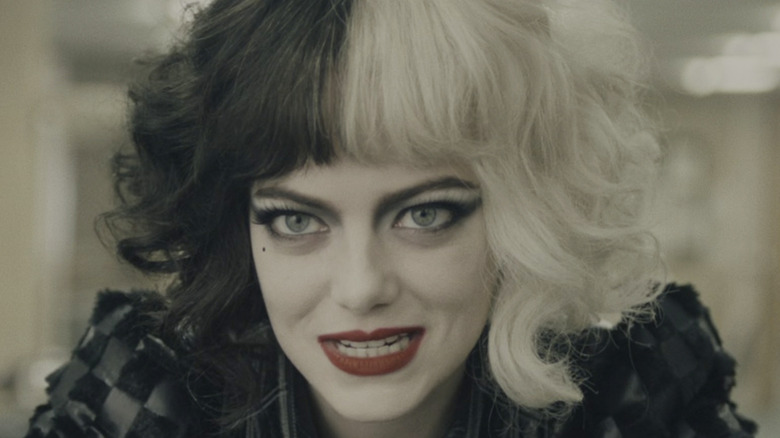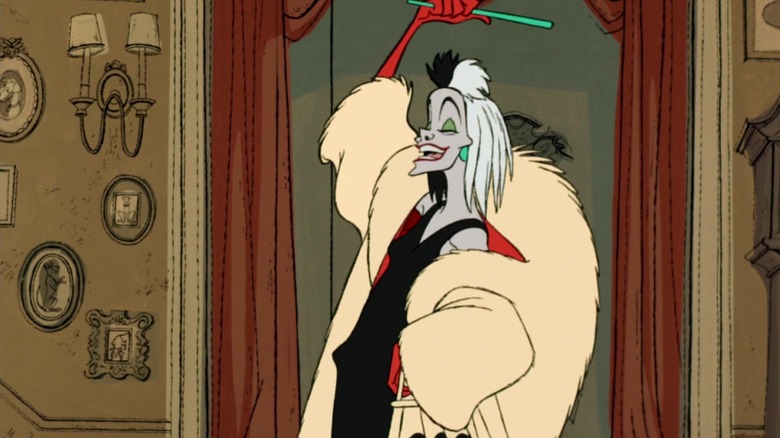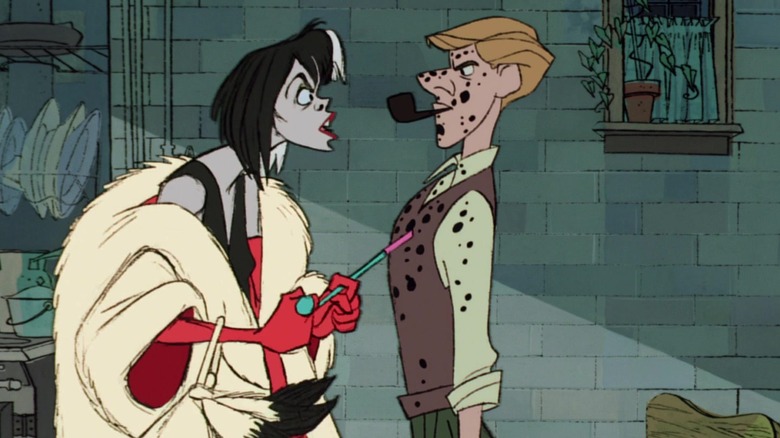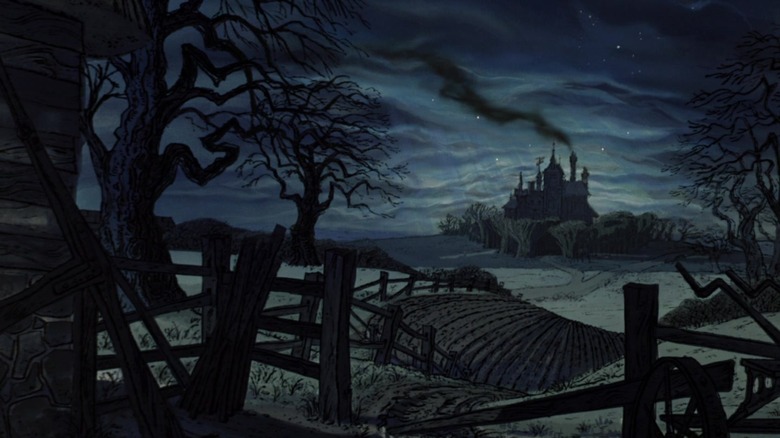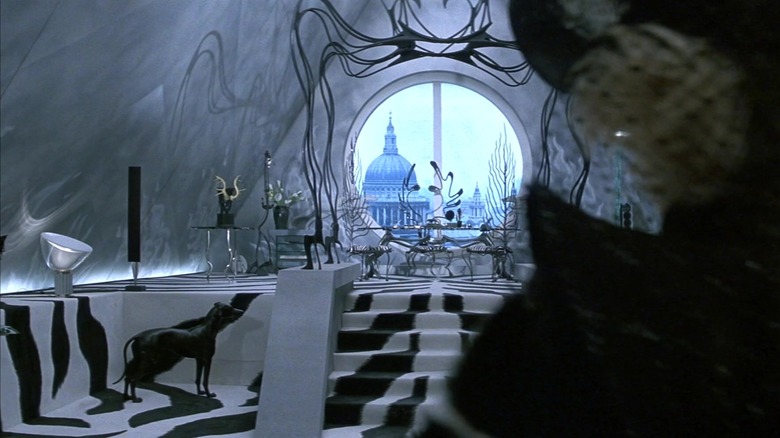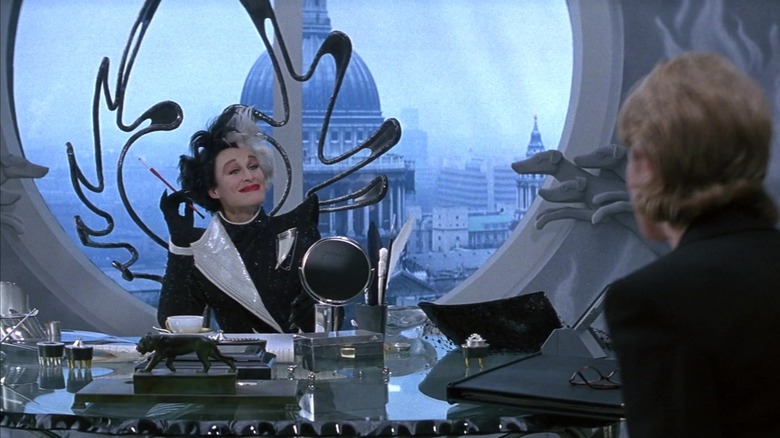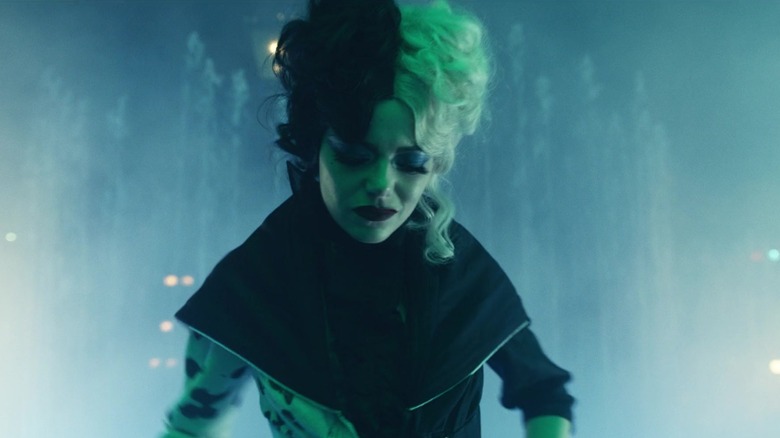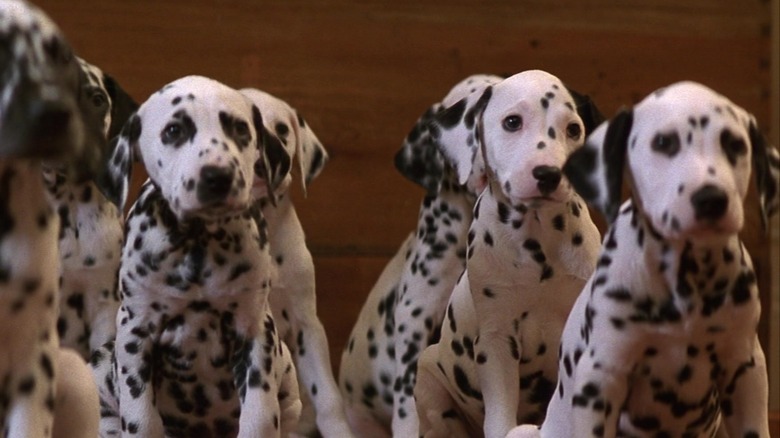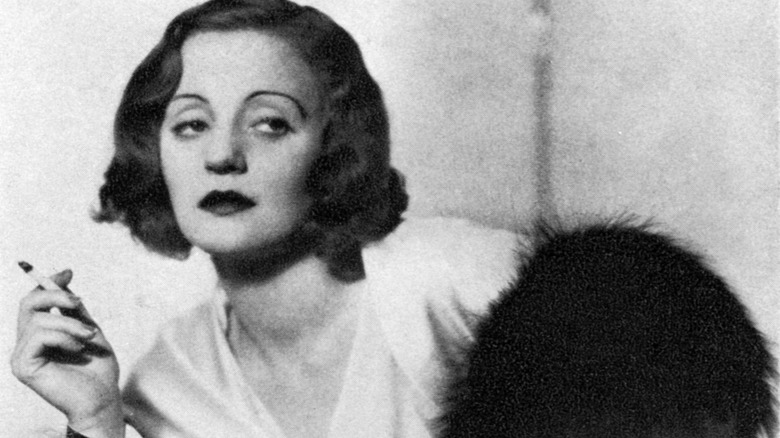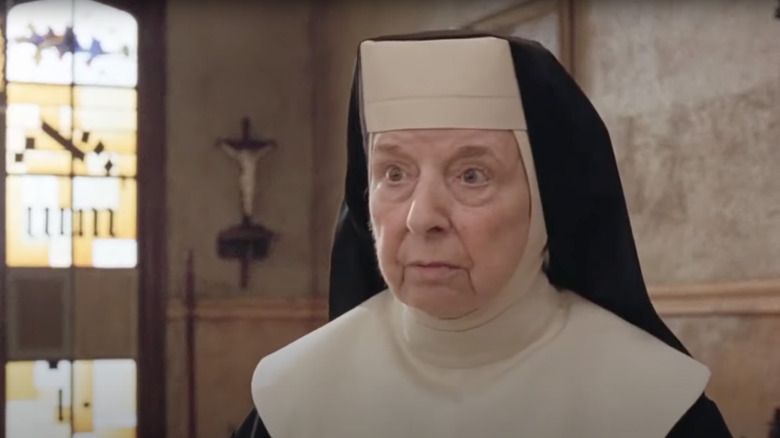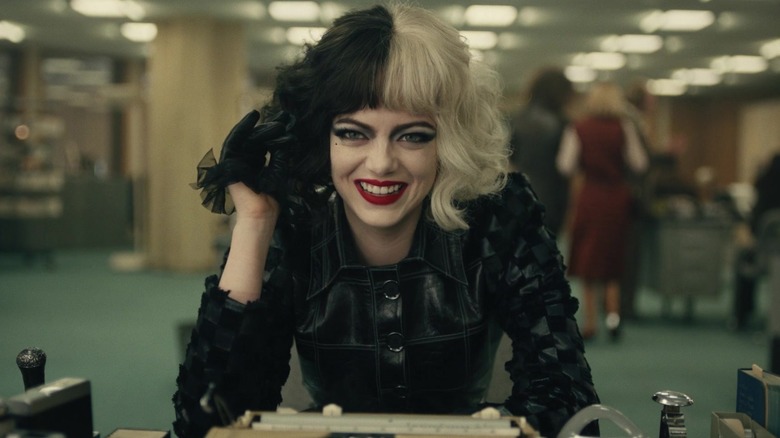The Dark History Of Cruella
Cruella de Vil is one of the most iconic villains in pop culture. Who else has an instantly-recognizable theme song and an even more seminal style?
Since the character's debut appearance in the 1961 animated film "One Hundred and One Dalmations," Cruella has been a character viewers have loved to hate so much that, in many cases, the feeling has turned into outright love. Cruella is single, wealthy, successful, knows what she wants, and isn't afraid to go and get it, making her the perfect "girl boss" for the modern day. Disney capitalized on this love of the villain with the 2021 live-action film "Cruella," which reimagined the character for a new generation, giving her a punk-fashion backstory.
But despite how much fun Cruella is, she's still a villain. In many cases, especially in the 1956 book upon which "Dalmations" was based, she truly lives up to her name. "I think Cruella basically has no redeeming human characteristics," actress Glenn Close told the Associated Press in 2016. "She's a great character. She's gleeful in her evilness, and there's something very engaging about that." Here's a look into the dark backstory of the lovably unlovable Cruella de Vil.
Her wealth is suspect
The Cruella we know from the Disney film adaptation is enormously wealthy. In fact, Forbes once estimated her net worth to be upwards of $1 billion.
However, according to the "One Hundred and One Dalmations" novel, Cruella's wealth is not what it appears. While her family had historically been wealthy, it is revealed at the end of the book that she is in debt. Her luxurious furs were acquired through her husband, a furrier, but hadn't actually been paid for. Additionally, the many jewels Cruella owned turned out to be fake. In the end, she and her husband fled London to escape their debts, and the white half of her hair turned green from all the stress.
In the 1996 live-action adaptation starring Close, Cruella was presented as a fashion magnate with her own house. While this legitimized some of her money, she was also using her wealth to obtain illegal furs. Emma Stone's Cruella in the 2021 prequel, meanwhile, essentially stole her inheritance from her biological mother after framing her for murder.
She kills cats
In the original novel, Cruella has a pet: a white Persian cat. The cat is described as "most beautiful," but Cruella isn't interested in the animal's beauty.
"I don't like her much," she says. "I'd drown her if she wasn't so valuable."
After Mrs. Dearly visits Cruella's home, the cat follows her home, and the Dearlys feed it, and the cat appears to want to stay before it's scared off by the dogs. And it's no wonder. Later in the book, the cat reveals that it has given birth to 44 kittens over the years, and that Cruella drowned every single one of them.
However, the cat does get some revenge, as she tells Pongo: "I scare the servants away — any cat can make a house seem haunted. I let the place become overrun with mice. And, oh, how I scratch the furniture!" After the cat helps all of the dogs escape Hell Hall, Pongo and the puppies offer to help the cat get back at Cruella. Together, they destroy all of Cruella's furs.
She has a dark family history
Cruella's ancestral home is named Hell Hall, although that wasn't always the case. In Dodie Smith's novel, it's explained that one of Cruella's ancestors bought "Hill Hall" from a farmer, and then renamed it and painted it black. In the nearby village, rumors soon began to spread: "Once the wall, with its heavy iron gates, was finished, strange rumors began to spread. Villagers crossing the heath at night heard screams and wild laughter." The villagers claim that Cruella's ancestor had a tail, and that he was the devil himself.
This all came to a head when the villagers formed a mob and went with torches to burn down Hell Hall. When they approached, a thunderstorm began, and legend has it that the lightning wasn't coming from the sky, "but from de Vil — blue forked lightning." In case all these supernatural rumors aren't enough, the book also reveals that one of Cruella's ancestors was believed to be a serial killer.
Her apartment's style inspiration was Hell itself
If Cruella's surname were not indication enough, her apartment's styling would be enough to make you associate her with devils and demons. In Dodie Smith's novel, Cruella hosts a dinner party at her city home. The first thing her guests notice is the colors: the dining room has walls of black marble, and the drawing room is all red marble. The second thing the guests notice is the unusual food: "Everything tasted of pepper, even the ice cream — which was black."
When they all finish eating and go to sit in the drawing room, Cruella immediately focuses on the fireplace and tells her husband, "Make it blaze for me." While all of the other guests are panting and sweating, Cruella bemoans that the huge flames never last long enough. It seems Hell Hall would be an appropriate name for Cruella's apartment as well as her country mansion — and while the film adaptations don't portray Cruella's living situation as being quite so cartoonish, they do use the same stark colors for Cruella's dramatic fashion taste.
She's an abusive boss
Beginning with the 1996 adaptation of "101 Dalmatians," which starred Glenn Close as Cruella, she has been a cruel boss. Close's Cruella is the owner of a fashion house, and rather than being connected to Anita from her school days, Anita is Cruella's assistant at the fashion label. Cruella, of course, is a rather terrifying boss, in many ways similar to Meryl Streep's Miranda Priestly in "The Devil Wears Prada."
This means that when Cruella asks Anita for the dalmatian puppies, there's an added layer of menace, as Anita's job could be threatened if she refuses. Despite this abuse of power, Anita refuses to sell Cruella the dogs.
In "Cruella," the iconic character is given a more sympathetic underdog backstory, but that doesn't make her much of a better boss. Despite being frustrated by the actions of Baroness von Hellman, Cruella emotionally manipulates her friends Jasper and Horace into doing tasks for her, even when they believe she's going too far.
She's a complicated figure for feminism
"Cruella" portrays the character of Cruella de Vil as a girl-boss anti-hero — a person for whom being "bad and a little bit mad" is ultimately empowering. However, Cruella has not always been this way.
In the novel, Cruella is not the single society woman we've come to know through the films. Instead, she's married. The fact that she makes her husband take her name rather than the other way around is portrayed as another indicator of her evil nature.
In the 1961 animated Disney film, Cruella is single, and her negative traits are very much linked to that fact; The Take notes that Cruella is linked with witches and spiders, and that she has many of the stereotypical qualities associated with "spinsters."
While Cruella's gleeful celebration of her unmarried status and her uninhibited ambition have, over the years, made her into a girl power icon, it's important to remember that she didn't start out that way. Her very name is a reminder that her independence and ambition were once seen as negative traits for a woman.
Cruella and 101 Dalmatians led to issues with Dalmatian adoptions
Following the release of the 1996 live-action adaptation of "101 Dalmatians," the demand for dalmatian puppies soared. However, this had some dark consequences.
In 1997, The New York Times reported that, nationwide, animal shelters reported an increase in the number of surrendered dalmatians, noting that many of the unwanted dogs "were given to children as gifts last Christmas after the release of Disney's remake of the movie '101 Dalmatians.'" PETA reported that the "impulse-buying boom" led not only to surrenders, but also many animals abandoned or neglected.
Unlike the perfectly-behaved dogs that appear in the films, a dalmatian's intelligence makes it a more high-maintenance species. PETA warns that they are "very energetic dogs who require more attention and patience than people may expect." Additionally, the breed can have complicated health issues. These issues can get worse with poor breeding practices, much of which occurred as the demand for dalmatians boomed.
The issue was significant enough that 2021's "Cruella" included a disclaimer encouraging "adopt, don't shop" practices and reminding viewers that every dog deserves a loving home.
One of Cruella's main inspirations has a tragic story
There is perhaps no one more responsible for Cruella de Vil's iconic persona than animator Marc Davis, one of Disney's original "Nine Old Men." Davis did the design and primary animation of Cruella for Disney's 1961 cartoon adaptation of Dodie Smith's novel. While Davis drew inspiration from a number of people, Cruella's look and mannerisms were taken primarily from actress/socialite Tallulah Bankhead.
Bankhead was one of the first modern celebrities, coming from a wealthy Alabama political family (her grandfather and uncle were U.S. Senators, her father Speaker of the House). Described by biographer Lee Israel as "a soft-spoken, blond tubercular – well cultivated, bisexual, with sensuous, meaty lips, a distant, antic charm, a history of mysterious disappearances, and a streak of cruelty," her childhood was marked by neglect and abuse, and she suffered from depression and substance abuse — the least of which being a reported vice of smoking 120 cigarettes a day.
While she had major successes on stage, screen, and radio (she was a particular standout in the 1944 Alfred Hitchcock classic "Lifeboat"), she was reckless with her money, and was notoriously risky when it came to sex (she almost died after she contracted gonorrhea). In the last fifteen years of her life, her depression became even more acute, as did her substance abuse, and she spent most of the years prior to her 1968 death extremely ill.
If you or anyone you know is struggling with addiction issues, help is available. Visit the Substance Abuse and Mental Health Services Administration website or contact SAMHSA's National Helpline at 1-800-662-HELP (4357).
The main physical reference model for Cruella's 1961 design went uncredited
In order to aid with their animation, Disney animators would often bring in actors to serve as reference models for the characters. These models would demonstrate movements and be examples for the characters' physicality.
For Cruella de Vil, the reference model ended up playing a large part in the character up on screen, even though they weren't credited in the film. In fact, Cruella's real-life model was someone you may recognize: character actress Mary Wickes. Wickes was known for playing housekeepers and gossips, and appeared in films like "White Christmas" as well as "Sister Act (pictured above)."
Wickes was the perfect reference for Cruella. "She had very distinctive features," biographer Steve Taravella told EW. "She was tall, lanky, and had exaggerated expressions; she was limber and could easily contort her body. She wasn't afraid to do physical comedy." According to EW, the Disney animators would play the recorded voice track for Cruella, and then Wickes would act out Cruella's dramatic movements. This gave Cruella many of the distinctive mannerisms and movements seen in the film.
And while Wickes wasn't formally credited for the film, Taravella says she wouldn't have minded it, even as a relatively famous actress. "Mary wanted nothing more than to work constantly," he told EW. "She loved work ... she was a real old school working actress."
She abuses animals
While "Cruella" has transformed the character of Cruella de Vil into an aspirational punk hero, there are many critics who aren't buying Cruella's new status. After all, Cruella is known first and foremost for one thing: a love of fur so strong that she attempts to kill 101 puppies to feed her obsession.
In the book, Cruella drowns kittens and attempts to get the puppies to fight each other to the death. In the 1996 film, Cruella commands the puppies be killed in increasingly terrible ways: "Chloroform them! Drown them!" she yells. Actress Glenn Close told Yahoo! that she often ad-libbed such lines, "because the worse she was, the more effective she was." There's a reason that PETA has made many complaints about the films and why an academic would call the 1996 version a "provocative piece of pro-fur rhetoric" (via Glamour).
With "Cruella," Disney did its best to distance the Emma Stone iteration of Cruella from animal cruelty. In the film's production notes, Disney stated "in our film, the character Cruella does not in any way harm animals ... Cruella doesn't share the same motivations as her animated counterpart" (via The Guardian). While Cruella de Vil is known as being black and white, her motivations, it seems, have become anything but.
